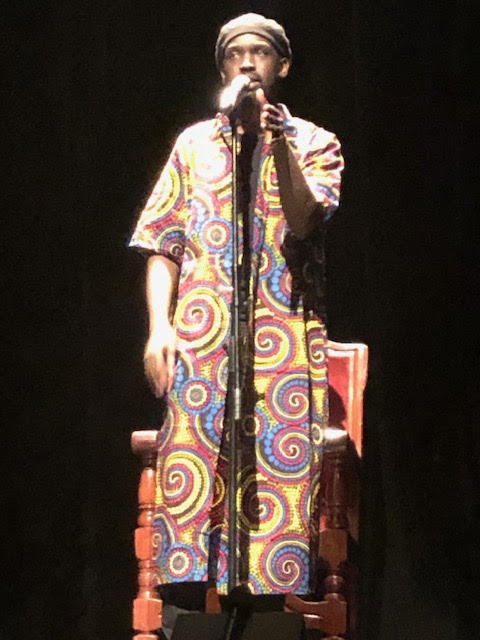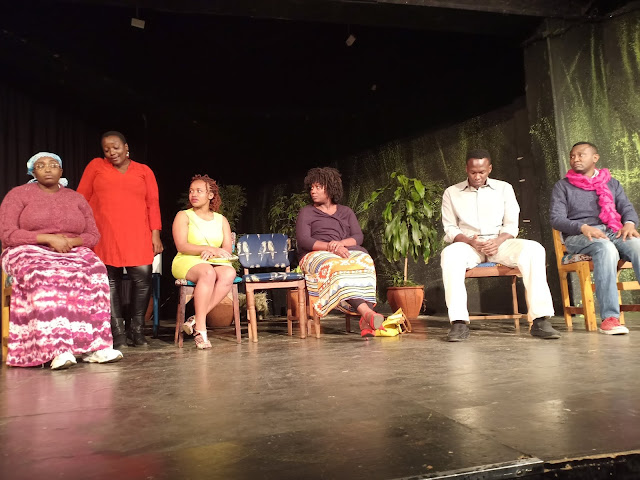Graffiti artist Chela painted walls, doors and ceiling at Kukito in 2019
BY Margaretta
wa Gacheru (posted 30 December 2019)
While a
number of Nairobi art spaces shut their doors in 2019 (some temporarily, others
permanently), and others lost a degree of artistic energy, the local visual art
scene remained vibrant nonetheless.
David Thuku, cofounder of Brush tu exhibits with One Off Gallery now but is based at Kobo Trust
The leading
lights in Kenya’s art industry thrived in 2019. These include galleries like
One Off, Circle Art, Red Hill and Banana Hill, all of which were busy
throughout the year. They as well as venues like the Nairobi National Museum,
Alliance Francaise, Goethe Institute and Nairobi Gallery were also booked solid
all year.
Victor Mwangi is based in Railway Museum studio but exhibited in 2019 at One Off
Nonetheless,
there were many artists who felt disheartened, given the virtual shut down of
spaces like the GoDown, Polka Dot Gallery, the Attic, Shifteye Gallery and Paa
ya Paa, all of which had once promised artists limitless possibilities for
exhibiting their art.
Yet as
demoralizing as the shut downs may have seemed, they stimulated lots of fresh
initiatives on artists’ and curators’ part.
Many resorted to mounting Pop-Up exhibitions.
Ooko used to exhibit at the now defunct Gallery Watatu. In 2019 he showed at Chelenge's Home Studio
Among the spaces that were
popular for pop-ups were various hotels, restaurants, and malls as well as
offices like Ikigai and Ogilvy Africa. Hotels that opened their doors to local
artists included the Sarova Stanley, Fairmont Norfolk, Trademark, Tribe, Intercontinental,
Sankara and Radisson Blu where the Art Auction East Africa will again be held
in March, curated by Circle Art. And even country clubs like Muthaiga and Karen
Clubs hosted pop-up shows in 2019.
At Village Market with Evans Ngure, Patrick Kinuthia, Milena, Usha, Kathy Tate-Bradish and me
The most
popular malls that showcased artists’ work were Village Market, Lavington Mall
and Roslyn Riviera (where One Off opened up an ‘annex’ late in 2018 which has
been busy ever since).
Restaurants
like Talisman and Que Pasa have been hosting artists’ works for years. But in
2019. venues like the Lord Errol, Alchemist, Wasps and Sprouts, 45 Degrees
Kitchen, Lava Latte and even fast food eateries like Kukito have not just
mounted exhibitions. Some have even invited graffiti artists to cover whole
walls with their art.
Nelson Ijakaa photographed model Naitiemu for exhibition at The Attic which closed in 2019
One other major
trend that picked up in 2019 was artists setting up their own art venues.
Adrian Nduma did it sometime back with Bonzo Gallery; Nani Croze did it when
she started Kitengela Glass and even Patrick Mukabi established Dust Depo both
to show his own and others’ art and to mentor young artists. But more recently,
we’ve seen Paul Onditi open his own Art Cupboard, Chelenge van Rampelberg
launch her Home Studio, Kioko with Kioko Mwitiki Gallery, Jeffie Magina with
Studio Soko, Adam Masava with Mukuru Art Club and George Waititu did it by building
his own Tafaria Castle Art Museum.
Florence Wangui began studio work with Makabi at the GoDown. Now she is signed with One Off
In fact, a number
of artists have moved out of town and opened home studios, including
photographer James Muriuki, C-stunners’ Cyrus Kabiru and painters like Peterson
Kamwathi, Yony Waite, Zihan Herr, Peter Elungat, Geraldine Robarts and others.
Interning artist at Brush Tu Art Collective 2019
At the same
time, artists’ collectives proved to be one of the best places to see art ‘works
in progress’ in 2019. These include spaces like Brush Tu, Maasai Mbili, Kobo
Trust, Kuona and BSQ which is part of a thriving arts community at the Railway
Museum. For not only is Dust Depo there. There’s another art space just next
door, and right behind the Museum, there are railway cars transformed by
graffiti artists like BSQ into studios cum gallery spaces.
Coster Ojwang exhibited at Polka Dot Gallery before it had to move out of the Souk, Karen, 2019
What’s more,
BSQ has carried on the tradition initiated by Mukabi of mentoring up-and-coming
artists. The main difference between the two is that BSQ mentors graffiti
artists whom they also invited in 2019 to carry on another tradition, of spray-painting
graffiti art on the ‘Great Wall’ of the
Museum that stretches all the way from the Technical University of Kenya down
to the Museum, creating a collective work of art that changes periodically just
as graffiti does worldwide.
Part of the 'Great Wall of Railway Museum' 2019
Finally, a
number of events stood out dramatically this past year. One was the Art Auction
East Africa which is an annual event. But this past year at Radisson Blu, there
were record-breaking sales of regional art which effectively illustrated how fine
art can be taken seriously by Kenyans as a profession and livelihood.
Kids by Patrick Mukabi of Dust Depo Art Studio
The other
landmark moment for Kenyan and other regional artists in 2019 was One Off
Gallery’s opening its own Sculpture Garden on more than two acres of ground. The
Garden turned out to be not just one venue for viewing the wide range and
beauty of East African sculpture. Carol Lees’ call out attracted so much amazing
art that it filled the garden as well as indoor galleries at One Off and the onr
at Rosslyn Riviera mall.
Wildebeasts by Yony Waite, cofounder of defunct Gallery Watatu showed at Polka Dot in 2019 before it closed





















